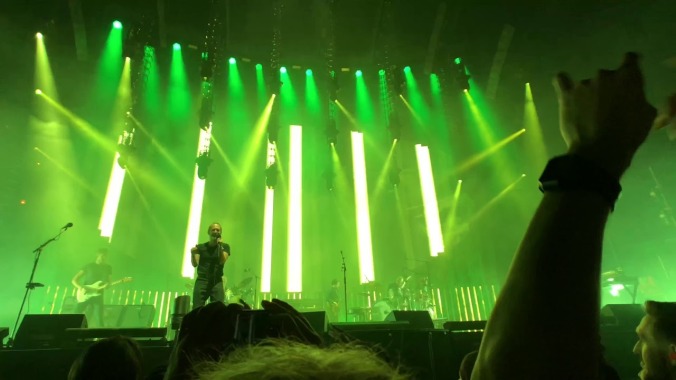Radiohead is somehow getting better

Radiohead has been so good for so long that it is almost obnoxious to make this argument in public. (I’m sorry.) Depending on how you define its peak—say, from 1995’s The Bends to 2007’s In Rainbows—Radiohead remained the consensus pick for largest and best band on the planet longer than any other claimants to the throne (U2, R.E.M., Talking Heads, The Rolling Stones, and so on), and it’s settled into its post-peak life with admirable polish, releasing two quiet albums—one exploratory, the other pained and internal—that sit proudly among its earlier works. Throughout, it’s remained a maddeningly consistent live act for the same reason that the albums themselves have stayed relevant: Thom Yorke’s dystopian vignettes are drawn with IMAX-scale emotions, cataclysmic climaxes, and restless self-editing. They’re downers, sure, but at a celestial scale. The light shows always kick ass. The band never fucks up, it pretty much always plays two encores, and it’s toured, more or less constantly, for the past two decades.
This year was supposed to be different—guitarist Ed O’Brien said they’d “hang up (their) Radioheads” to focus on solo work—until all of a sudden it wasn’t, and the band announced a slate of major stadium shows throughout North America, including multi-night stints in Chicago, New York City, and Boston. It shook the rust off in Chicago on Friday with a jagged 25-song set, cutting a melancholy path through its body of work that jerked to life via intermittent flashes of the band’s noisier, more chaotic stuff. Tracks like “Daydreaming,” “Morning Bell,” and “How To Disappear Completely” set a baseline tone of the band at its dreamiest, a star-lit mood that made the strobe-lit chaos of “Myxomatosis” or “Paranoid Android” almost corporeally powerful. The band was aided immeasurably in these efforts by the full-set addition of percussionist Clive Deamer, a Portishead vet who helped turn Radiohead’s studio manipulation of drummer Phil Selway into a real-life, four-limbed monster. By closer “There There,” Radiohead’s obsession with percussion had grown to encompass two-thirds of the people onstage. The first live performance of Pablo Honey’s “Blow Out” in a decade felt like an appropriate addition here: all raw power, sheets of jagged guitar when you least expected it.
The next night the band played a very different set, leaning more heavily into itchy glitch-hop and acoustic material, which is the sort of thing you can do when you’ve got nine records pored over by stadiums full of people across the globe. At this point, Radiohead can tour playing the Great Dystopian Songbook forever, better and tighter and louder with each passing year. Even the set design seemed to underline this, with an oblong oval behind the band that broadcast an endless montage of the band members at work, all frets and cymbals and studious faces, a cohesive unit of professionals who will seemingly never stop doing this. In between tracks, as roadies dutifully replaced guitars and wheeled out a new gigantic box for Jonny Greenwood to plug things into, a sole mirrorball lit the stadium, a quick neutral moment as the band spooled up some new selection from the catalog. About a decade removed from its peak, and touring behind a fractured, tortuous album, anybody who really wants to see Radiohead has probably already had the opportunity to do so, which can make the prospect of shelling out yet again seem moot. But the strangeness of this sexless, dreary band’s enduring super-stardom remains a phenomenon worth seeking out. There does not seem to be a reason for this tour beyond the fact that the band wanted to do it, and perhaps that there is a sense of public service in letting a stadium full of people scream about the coming ice age to each other.